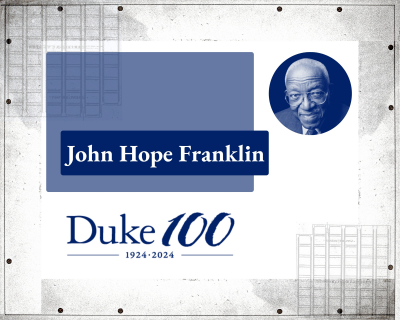Adriane Lentz-Smith, Associate Professor of History

John Hope Franklin’s “From Slavery to Freedom” offered a cogent, comprehensive history of African Americans at a time when most white Americans did not believe that Black people had a history worth telling.
First published in 1947, two years after the American victory over German white supremacists in World War II and decades into the Black freedom struggle against American white supremacy, the book did not simply provide a one-volume, “History of Negro Americans,” as the subtitle put it. It constructed a sweeping, expansive portrait of a United States shaped by the labor, politics and culture of African-descended peoples — a nation shaped, too, by the continual contending with the questions of freedom and unfreedom that had long set the horizons and limits of American democracy.
One could not understand what America was and is, Franklin asserted, without knowing African American history. Over 3 million copies and several editions later, the book remains in print.
One of the glorious things about history books is that they both connect us to other moments in time and root us in the time we inhabit. The many editions of “From Slavery to Freedom” serve as both secondary and primary sources: The research in each chapter enriches our understanding of the American story; the context of each editions’ production, the revision and the artwork all speak to the moment of publication — a snapshot of that present as much as chronicle of the past.
And our experience as readers marks a moment in our own personal histories. I own three editions of Franklin’s work, and each tells me something different. The tenth is the most functional: A blue, hardbacked brick of a book, it has a close-up of the national Martin Luther King Jr. Memorial on its cover and feels most fully like something you might find in a college survey course.
The ninth edition is the most striking. Published in the afterglow of America electing its first Black president, it deliberately connects Franklin’s work to that historic moment. The cover features a black and white photo of an enslaved family — a young woman and several sober-faced children — superimposed on the red, white and blue of an American flag. In the foreground, Barack Obama faces the flag with his arm outstretched, a celebration of his inauguration and of the promise of the unfolding, unfinished American project.
Still, if the ninth edition both records and reflects a national history, it is the seventh that I hold most dear. That edition changed my life and learning as a young history major. It ushered me into the dynamism of the past, into an understanding that the forced diaspora of African peoples created new worlds across the Americas and Europe, into the realization that the salience of African American history to U. S. or global history could not be winnowed down to a cursory discussion of the Civil Rights Movement nor addressed in a small bit of programming during Black History Month.
Never a tale of linear progress, the book demonstrated something civil rights activists had long asserted: that freedom is a constant struggle. More important to me as an undergraduate, it drove home the fact that the story of African Americans was bigger than a story of struggle alone. Alongside its account of the nurturing and pursuit of a Black freedom politics, the book gave a rich picture of the heterogeneity and fecundity of Black thought and culture. The story of Black people, I came to understand, had to be refracted through multiple lenses.
John Hope Franklin taught me and countless others how to couple a scholar’s sensibility to a citizen’s responsibility. He broke ground by becoming, at Brooklyn College, the first Black chair of an academic department in a historically white college and later by serving as the first Black president of the American Historical Association. As a public intellectual, he pushed contributed research to the Brown v. Board of Education case in the 1950s, marched in Selma in the 1960s, chaired the President’s Commission on Race in the 1990s and was awarded the Presidential Medal of Freedom in 1998.
But a survey of his vitae does not quite capture the awe he inspired. For that, it takes the words of Duke scion Mary Duke Biddle Trent Semans, who described Franklin and his wife, Aurelia, as “American royalty.” They were, she eulogized at his 2009 memorial service in the Chapel, “our symbols of goodness.”
Duke and Durham abound in memorials to John Hope Franklin’s scholarship, and his goodness. Amidst the institutional names, endowed chairs and dedicated highways, there sits his canonical, foundational book. Over 75 years old now, “From Slavery to Freedom” still pulses with life, encouraging Americans to engage the past in its rich, sometimes painful complexity, and to put that unflinching knowledge in service to a better present and future.